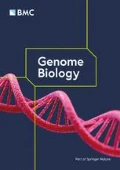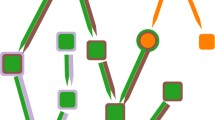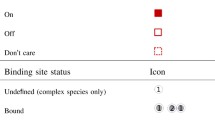Abstract
Background
We propose that a computerized, internet-based graphical description language for systems biology will be essential for describing, archiving and analyzing complex problems of biological function in health and disease.
Results
We outline here a conceptual basis for designing such a language and describe BioD, a prototype language that we have used to explore the utility and feasibility of this approach to functional biology. Using example models, we demonstrate that a rather limited lexicon of icons and arrows suffices to describe complex cell-biological systems as discrete models that can be posted and linked on the internet.
Conclusions
Given available computer and internet technology, BioD may be implemented as an extensible, multidisciplinary language that can be used to archive functional systems knowledge and be extended to support both qualitative and quantitative functional analysis.






Similar content being viewed by others
References
Karp PD: Metabolic databases. Trends Biochem Sci. 1998, 23: 114-116. 10.1016/S0968-0004(98)01184-0.
From sequence to function. An introduction to the KEGG project. [http://kegg.genome.ad.jp/kegg/kegg2.html]
McAdams HH, Shapiro L: Circuit simulation of genetic networks. Science. 1995, 269: 650-656.
Takai-Igarashi T, Nadaoka Y, Kaminuma T: A database for cell signaling networks. J Comput Biol. 1998, 5: 747-754.
Transpath home page. [http://193.175.244.148/index.html]
Kohn KW: Molecular interaction map of the mammalian cell cycle control and DNA repair systems. Mol Biol Cell. 1999, 10: 2703-2734.
MODULES in extracellular proteins. [http://www.bork.embl-heidelberg.de/Modules/extra.html]
BioD model of G1/S checkpoint machinery. [http://www.rainbio.com/BioD_G1-S.html]
BioD model of the ketogenic diet and epilepsy. [http://depts.washington.edu/perc/infoscientists/ketogenicdiet/KD_Events.html]
Sherr CJ, Roberts JM: Inhibitors of mammalian G1 cyclin-dependent kinases. Genes Dev. 1995, 9: 1149-1163.
Harper JW, Elledge SJ: Cdk inhibitors in development and cancer. Curr Opin Genet Dev. 1996, 6: 56-64.
Sherr CJ: Cancer cell cycles. Science. 1996, 274: 1672-1677. 10.1126/science.274.5293.1672.
Kaldis P: The cdk-activating kinase (CAK): from yeast to mammals. Cell Mol Life Sci. 1999, 55: 284-296. 10.1007/s000180050290.
Sherr CJ, Roberts JM: CDK inhibitors: positive and negative regulators of G1-phase progression. Genes Dev. 1999, 13: 1501-1512.
Ptashne M: A Genetic Switch. Cambridge, MA: Cell Press;. 1992, 20-28.
Gelbart WM: Databases in genomic research. Science. 1998, 282: 659-661. 10.1126/science.282.5389.659.
Extensible Markup Language (XML) 1.0 (Second Edition). [http://www.w3.org/TR/REC-xml]
Mackenzie D: New language could meld the Web into a seamless database. Science. 1998, 280: 1840-1841. 10.1126/science.280.5371.1840.
Fenyo D: The Biopolymer Markup Language. Bioinformatics. 1999, 15: 339-340. 10.1093/bioinformatics/15.4.339.
The Physiome Markup Languages. [http://www.physiome.org.nz/]
Systems Biology Markup Language [SBML]. [http://www.cds.caltech.edu/erato/index.html]
XML Linking Language (XLink) Version 1.0. [http://www.w3.org/TR/xlink/]
McHugh J, Abiteboul S, Goldman R, Quass D, Widom J: Lore: A database management system for semistructured data. SIGMOD Record. 1997, 26: 54-66.
Backlund B, Hagsand O, Pehrson B: Generation of visual language-oriented design environments. J Vis Lang Comput. 1990, 1: 333-354.
Meyers BA: Taxonomies of visual programming and program visualization. J Vis Lang Comput. 1990, 1: 97-123.
Hargrove JL, Hulsey MG, Summers AO: From genotype to phenotype: computer-based modeling of gene expression with STELLA II. Biotechniques. 1993, 15: 1096-1101.
Barrett PH, Bell BM, Cobelli C, Golde H, Schumitzky A, Vicini P, Foster DM: SAAM II: Simulation, Analysis, and Modeling Software for tracer and pharmacokinetic studies. Metabolism. 1998, 47: 484-492.
Cobelli C, Foster DM: Compartmental models: theory and practice using the SAAM II software system. Adv Exp Med Biol. 1998, 445: 79-101.
Cook DL, Atkins WM: Enhanced detoxification due to distributive catalysis and toxic thresholds: A kinetic analysis. Biochemistry. 1997, 36: 10801-10806. 10.1021/bi971284b.
Cook DL, Gerber AN, Tapscott SJ: Modeling stochastic gene expression: implications for haploinsufficiency. Proc Natl Acad Sci USA. 1998, 95: 15641-15646. 10.1073/pnas.95.26.15641.
Bonarini A, Maniezzo V: Integrating qualitative and quantitative modeling. Int J Expert Systems Res Appl. 1991, 4: 51-70.
Fishwick PA, Zeigler BP: Creating Qualitative and Combined Models with Discrete Events. IEEE/Computer Society Press: Los Alamitos, CA,. 1991
Kuipers BJ: Reasoning with qualitative models. Artificial Intelligence. 1993, 59: 1-2. 10.1016/0004-3702(93)90162-5.
Kuipers BJ, Shults B: Reasoning in Logic About Continuous Systems. San Francisco, CA: Morgan Kaufman Publ.;. 1994
Eisenberg M: The kineticist's workbench: qualitative/quantitative simulation of chemical reaction mechanisms. Expert Systems Appl. 1991, 3: 367-377. 10.1016/0957-4174(91)90059-N.
Ursino M, Avanzolini G, Barbini P: Qualitative simulation of dynamic physiological models using the KEE environment. Artificial Intelligence Med. 1992, 4: 53-73.
Tyson JJ, Novak B, Odell GM, Chen K, Thron CD: Chemical kinetic theory: understanding cell-cycle regulation. Trends Biochem Sci. 1996, 21: 89-96. 10.1016/0968-0004(96)10011-6.
Thieffry D, Thomas R: Qualitative analysis of gene networks. Pac Symp Biocomput. 1998, 77-88.
KineCyte™ biological systems simulator. [http://www.rainbio.com/KineCyte.html]
Glasgow J, Narayanan NH, Chandrasekaran B: Diagrammatic Reasoning: Cognitive and Computational Perspectives. Cambridge, MA, The AAAI Press;. 1995
Corkill DD: Blackboard systems. AI Expert. 1991, 6: 40-47.
Buschmann F, Meunier R, Rohnert H, Sommerlad P, Stal M: Pattern-Oriented Software Architecture; A System of Patterns. New York: John Wiley and Sons;. 1996
DiBona C, Ockman S, Stone M: Open Sources: Voices from the Open Source Revolution. Sebastopol, CA: O'Reilly & Associates, Inc; 1999).
Gille H, Downward J: Multiple ras effector pathways contribute to G(1) cell cycle progression. J Biol Chem. 1999, 274: 22033-22040. 10.1074/jbc.274.31.22033.
Diehl JA, Cheng M, Roussel MF, Sherr CJ: Glycogen synthase kinase-3beta regulates cyclin D1 proteolysis and subcellular localization. Genes Dev. 1998, 12: 3499-3511.
Woodfork KA, Wonderlin WF, Peterson VA, Strobl JS: Inhibition of ATP-sensitive potassium channels causes reversible cell-cycle arrest of human breast cancer cells in tissue culture. J Cell Physiol. 1995, 162: 163-171.
Heist EK, Schulman H: The role of Ca2+/calmodulin-dependent protein kinases within the nucleus. Cell Calcium. 1998, 23: 103-114.
Wang S, Melkoumian Z, Woodfork KA, Cather C, Davidson AG, Wonderlin WF, Strobl JS: Evidence for an early G1 ionic event necessary for cell cycle progression and survival in the MCF-7 human breast carcinoma cell line. J Cell Physiol. 1998, 176: 456-464. 10.1002/(SICI)1097-4652(199809)176:3<456::AID-JCP2>3.3.CO;2-Z.
Acknowledgements
We thank Jim Roberts, Dan Gottschling and Barbara Trask for helpful discussion during the preparation of this manuscript.
Author information
Authors and Affiliations
Corresponding author
Rights and permissions
About this article
Cite this article
Cook, D.L., Farley, J.F. & Tapscott, S.J. A basis for a visual language for describing, archiving and analyzing functional models of complex biological systems. Genome Biol 2, research0012.1 (2001). https://doi.org/10.1186/gb-2001-2-4-research0012
Received:
Revised:
Accepted:
Published:
DOI: https://doi.org/10.1186/gb-2001-2-4-research0012




